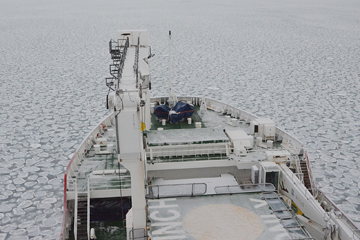Laboratory on the Icebreaker
Research in the Southern Ocean

© Sea Ice Team, SCALE Antarctica Winter Cruise 2019
Minus 19° Celsius and Arctic Ocean instead of 40° and Pool: Four UDE scientists have just spent three weeks on a research vessel in Antarctica. As part of an international team, they studied the ice in the Antarctic during the winter, which is crucial for the pole but also for the global climate.
100 scientists from 13 nations were on board the South African research vessel SA Agulhas II. For 21 days and 6,600 kilometres they took part in the major international climate protection research project SCALE (Southern Ocean Seasonal Experiment) to study the winter conditions in the Antarctic.
So it was not exactly the usual laboratory conditions under which the UDE engineers worked: "The cold was extreme," reports Dr. Carina Nisters. "We wore three layers of clothing all the time." And Prof. Jörg Schröder, head of the Institute of Mechanics, adds: "The temperature in the polar laboratory was constantly minus 10 degrees, which felt really warm compared to outside. But you couldn't stand it for more than an hour here either."
Earth's climate flywheel
The Southern Ocean is called the Earth's climate flywheel because it can absorb significant amounts of solar energy and increasing carbon dioxide emissions. But still too little is known about this gigantic system because of the adverse weather conditions and the remote location.
In a laboratory container on board the icebreaker, the scientists therefore took a close look at the physical, chemical, biological and mechanical properties of the ice. The "Sea Ice" team, which also included UDE researchers, took drill cores from large areas and from "pancake ice" - smaller floes with a bulging edge.
The waves that rolled under and alongside the 130-metre-long ship were up to 18 metres high. But even when the sea was calm, a sailor's walk was part of everyday life on board - tablets helped to prevent travel sickness.
Frazil ice
Using an apparatus specially designed for this expedition, the researchers also took and analysed samples of "Frazil ice". This consists of liquid water with the first frozen particles in it and only later becomes solid sea ice. Since the conditions in the Antarctic winter are particularly extreme, there are only a few data available so far. "Our results are now the basis for models that can analyse and predict the behaviour of clods under different conditions," explains Prof. Doru C. Lupascu, head of the Institute of Materials Science.
The expedition was led by the University of Cape Town (South Africa) and included 17 different research groups from the fields of biology, chemistry and engineering. It was funded by the South African National Research Foundation (NRF) through the South African National Antarctic Programme (SANAP), with contributions from the Department of Science and Innovation and the Department of Environmental Affairs.
in the picture:
SA Agulhas II paves its way through typical pancake ice
Further information:
Carina Nisters, Institute of Mechanics, Tel. 0201/18 3-3142, carina.nisters@uni-due.de
Editor: Birte Vierjahn, Tel. 0203/37 9-2427, birte.vierjahn@uni-due.de
